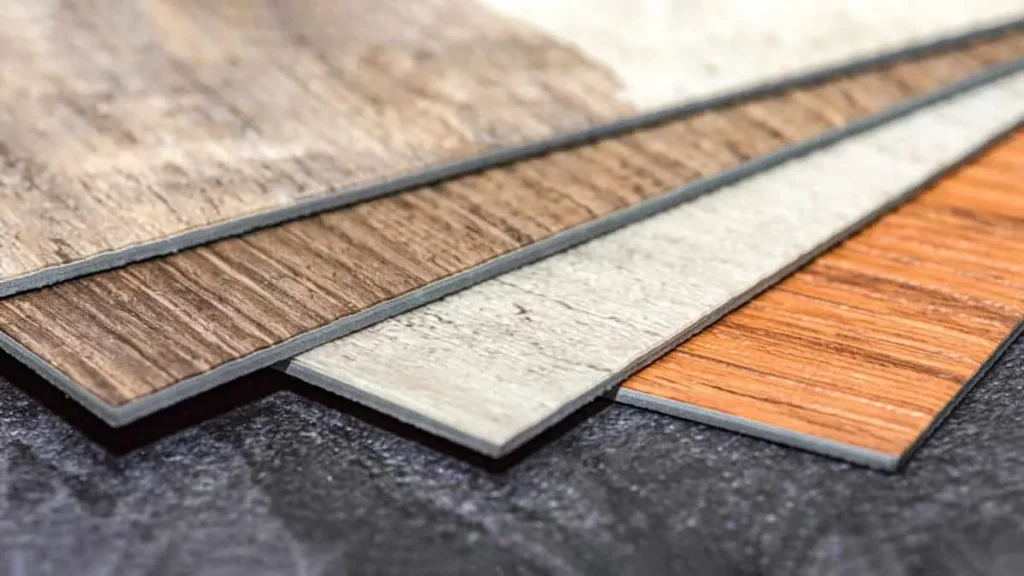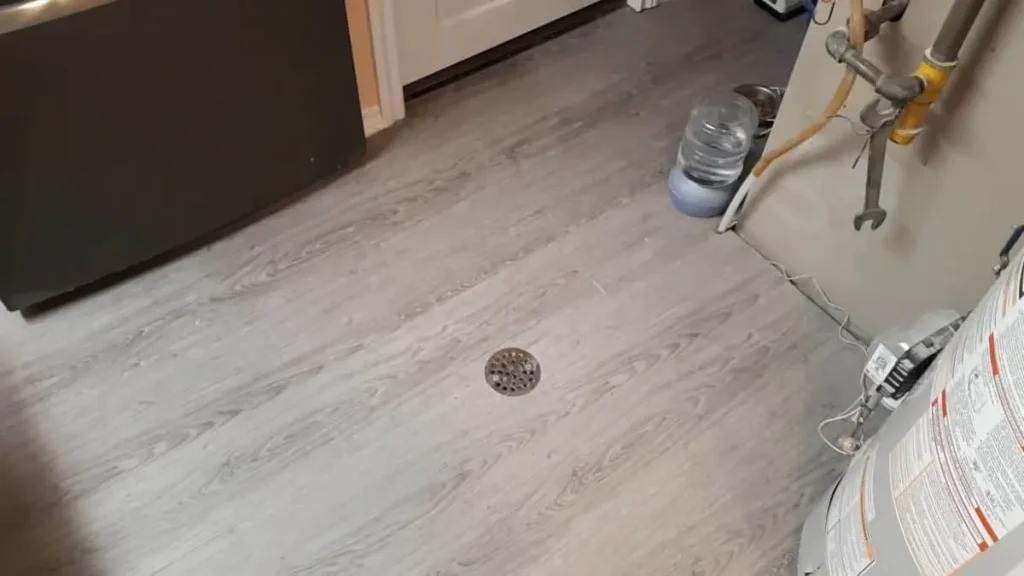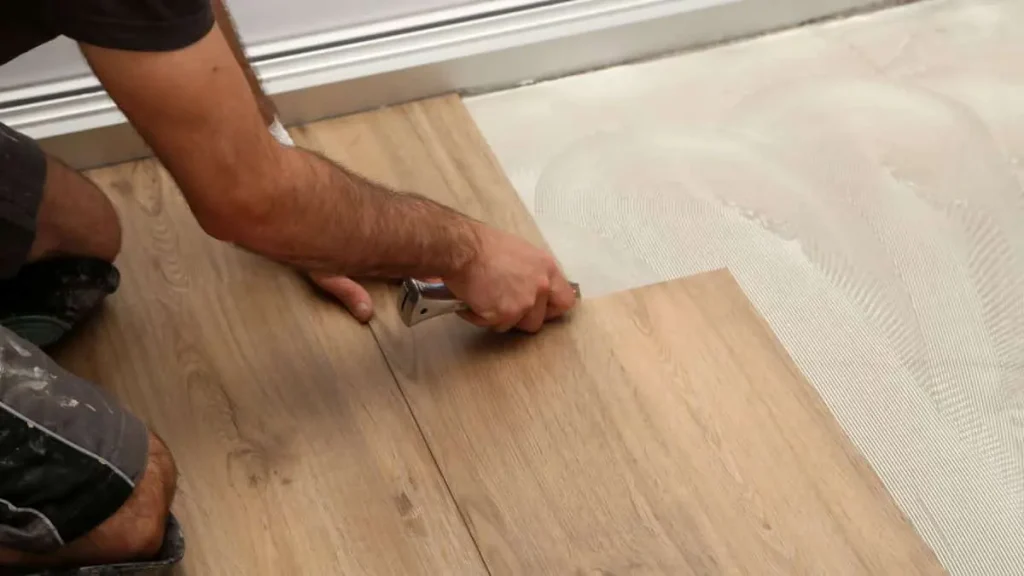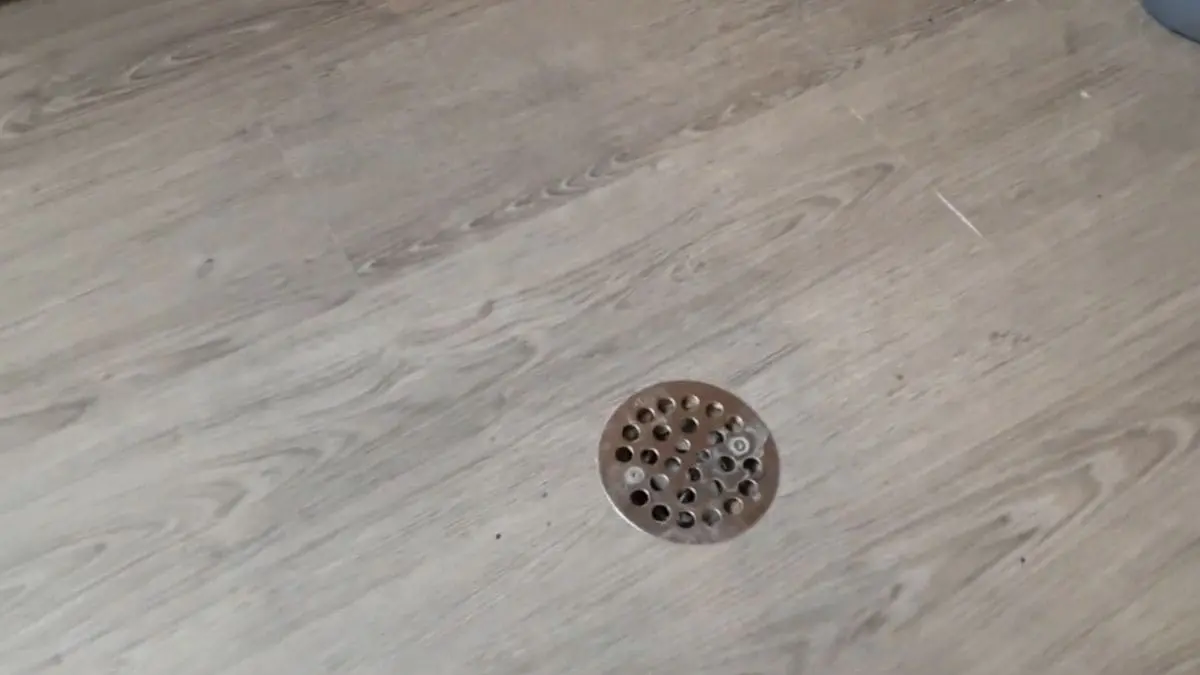Installing vinyl flooring around a floor drain requires careful attention to detail to ensure a smooth, professional finish. Floor drains are commonly found in basements, laundry rooms, and bathrooms, where moisture is a concern. Poor installation in these areas can lead to bubbling, improper drainage, and even damage to the vinyl over time.
When installed correctly, vinyl flooring not only enhances the look of the space but also ensures that water flows properly into the drain without causing any issues. In this guide, we’ll walk you through the step-by-step process of installing vinyl flooring around a floor drain. By following these clear and practical instructions, even first-time DIYers can achieve great results.
Preparation
Before we dive into the hands-on part of installing vinyl flooring around a floor drain, let’s lay the groundwork for success. Picture this as the behind-the-scenes action that sets the stage for a flawless performance.
First and foremost, take a moment to assess the floor drain and its surroundings. Whip out your measuring tape, create a map, and check for any existing flooring issues. This step ensures we’re working with accurate measurements and a clear understanding of the canvas we have to work on.
Now, let’s clear the workspace. Remove any existing flooring materials, leaving us with a clean, blank canvas. Think of it as a fresh start. This not only allows for a smoother installation process but also ensures a level surface, a crucial factor for the longevity of your vinyl flooring. A level playing field, or in this case, a level floor, sets the foundation for a job well done.
So, roll up your sleeves, clear the clutter, and let’s get ready to transform your floor into something extraordinary.
Tools and Materials You’ll Need
Having the right tools and materials is crucial for a successful vinyl flooring installation, especially when working around a floor drain. Using the appropriate equipment will not only make the job easier but also ensure that the flooring is installed correctly, reducing the risk of issues like bubbling or poor drainage later on.
Gather the Right Tools Before You Begin
To start, you’ll need a utility knife. This will help you make precise cuts around the drain and along the edges of the vinyl. A straightedge or metal ruler is equally important, as it allows you to cut clean, straight lines without jagged edges. When it comes to measuring your floor area, a measuring tape is essential. Accurate measurements are critical to ensure that the vinyl fits properly, especially around the drain.
For smoothing out the vinyl after it’s been laid, consider using a floor roller. While not always necessary, a floor roller helps press the vinyl into place, removing any air bubbles and ensuring that it lays flat. Depending on the type of vinyl you’re using, you might also need adhesive. Some vinyl flooring comes with a self-adhesive backing, while others require additional glue to hold them in place securely.
A heat gun can be very helpful when working with stiff vinyl, especially around the drain area. Applying gentle heat allows the material to become more flexible, making it easier to mold and fit snugly around the drain. You’ll also need a pencil or chalk to mark the vinyl for cutting, ensuring that you know exactly where the drain is located. Finally, don’t forget your safety gear. Wearing safety gloves will protect your hands while handling sharp tools, and knee pads are a good idea if you’ll be spending extended time kneeling on the floor during the installation process.
Selecting the Right Type of Vinyl Flooring

Now, let’s talk about the unsung hero of our project – the vinyl flooring itself. Selecting the right type is akin to choosing the perfect cast for a movie; it can make or break the entire performance. In our case, the star of the show needs to be both visually appealing and highly functional.
When considering vinyl flooring around a floor drain, prioritize options that are waterproof or water-resistant. This is your first line of defense against potential water damage, ensuring your floor remains not only stylish but also resilient in the face of spills or drainage mishaps. Think of it as giving your floor a built-in raincoat!
Durability is another key player. Vinyl flooring comes in various thicknesses, and for areas around a floor drain, opting for a thicker vinyl can provide additional sturdiness. Now, let’s not forget about style. Vinyl flooring comes in an array of designs and patterns, so take a moment to envision how your chosen style will complement the overall look of your home.
Step-by-Step Guide to Installing Vinyl Flooring Around a Floor Drain
Properly installing vinyl flooring around a floor drain can seem challenging, but following the right steps ensures a smooth, professional finish. By paying attention to detail and taking your time, you can achieve a snug fit that allows water to drain effectively without compromising the look or functionality of your flooring.

1. Prepare the Subfloor and Drain Area
The first step in installing vinyl flooring is preparing the subfloor. It’s essential that the surface is clean, dry, and level before you begin. Sweep away any dust or debris that could interfere with how the vinyl adheres to the floor. If there’s unevenness or damage, address these issues first—either by patching holes or smoothing rough spots.
Next, take a close look at the drain. Ensure that it’s securely seated and functioning as it should. A simple way to check is by pouring a small amount of water to see if it drains properly. This step prevents future issues like water pooling or vinyl lifting around the drain.
2. Measure the Floor and Cut the Vinyl
Accurate measurements are critical when installing vinyl around a floor drain. Start by measuring the entire floor area where you plan to install the vinyl. This includes the location of the drain, so you’ll know exactly where to make your cuts.
If you’re using sheet vinyl, cut it slightly larger than needed, leaving extra material around the edges for any necessary adjustments. This ensures you won’t come up short once you start laying the flooring down. Take your time with this step—precision will make the installation process much smoother.
3. Cut a Rough Opening for the Drain
Once the vinyl is laid out, it’s time to cut a rough opening for the drain. Gently place the vinyl over the floor, feeling for the drain’s location beneath the material. Using a pencil or chalk, mark the spot where the drain sits. Then, use your utility knife to make a rough circular cut.
Keep in mind that this is just the initial cut—you’ll refine it later. Leaving a bit of excess material around the drain at this stage gives you the flexibility to adjust as needed for a perfect fit.
4. Fine-Tune the Cut Around the Drain
Now, focus on getting the vinyl to fit snugly around the drain. After the rough cut, smooth the vinyl down with your hands, pressing it into place around the drain. At this point, you can use your straightedge and utility knife to make a more precise cut, trimming closer to the drain’s edge.
It’s important not to cut too much material away. The goal is to have the vinyl sit flush against the drain, without being so tight that it causes buckling or damage. Adjust gradually, checking the fit as you go.
5. Heat the Vinyl for a Better Fit (Optional)
If your vinyl is stiff or difficult to work with, using a heat gun can make the material more pliable. Gently warming the area around the drain softens the vinyl, allowing it to conform more easily to the contours of the floor and the drain.
As you apply heat, be cautious not to overheat the vinyl. Keep the heat gun moving and hold it at a safe distance to prevent scorching or warping the material. Once the vinyl is warm, press it into place and allow it to cool. This will help the material retain its new shape, ensuring a snug, custom fit around the drain.
6. Secure the Vinyl with Adhesive (If Needed)
Securing the vinyl flooring properly is key to a long-lasting installation. Depending on the type of vinyl you’re using, you may need to apply adhesive. Some vinyl comes with a self-adhesive backing, while others require you to spread glue on the subfloor before laying the vinyl.
If adhesive is needed, carefully apply it around the edges and near the drain to ensure the flooring stays in place. Work in small sections, smoothing the vinyl as you go to avoid air bubbles. A floor roller can be particularly useful at this stage for pressing the vinyl evenly into place.
7. Check the Drain for Proper Functionality
Once the vinyl is in place, the final step is to ensure the drain works properly. Pour a small amount of water into the drain to make sure it flows smoothly and that the vinyl is seated correctly around the drain. The vinyl should be flush with the floor and not interfere with the drain’s ability to function.
This step is critical for preventing future drainage problems. By confirming that everything works as it should, you can avoid potential issues like water pooling around the drain or damage to the vinyl over time.
Recommended for you: Vinyl Flooring Install in Bathroom
Tips for Ensuring Proper Drainage

Now, let’s focus on a crucial element to ensure the long-term success of your vinyl flooring installation – proper drainage around the floor drain. Think of this as our backstage crew, making sure everything runs smoothly behind the scenes.
To kick things off, maintaining the functionality of the floor drain is key. Regularly check and clean the drain to prevent any blockages that could lead to water pooling around it. It’s a bit like routine maintenance for your car – a small effort that goes a long way in preventing issues down the road.
Now, let’s talk about the slope – not the dramatic kind, but the one that ensures water flows where it should. When installing vinyl flooring around a floor drain, make sure there’s a slight slope directing water toward the drain. It’s like designing a mini water highway, ensuring any spills or moisture find their way to the exit without causing trouble.
Sealing the edges and seams is our final touch. Picture this as adding the finishing touches to a masterpiece. Use a quality sealant to prevent water from seeping into the edges and seams of your vinyl flooring. It’s like giving your floor a protective shield, ensuring it remains resilient in the face of daily challenges.
Related Read: Dishwasher Drain Through Floor
Potential Challenges and How to Overcome Them
While installing vinyl flooring around a floor drain can be a rewarding project, there are a few common challenges that homeowners may encounter. Understanding these potential issues and knowing how to address them will help ensure a smooth installation process and long-lasting results.

Vinyl Buckling Around the Drain
One of the most frequent challenges is vinyl buckling around the drain. This occurs when the flooring is either cut too tightly or the material is not allowed to lay flat properly. Buckling can create an uneven surface, which not only looks unprofessional but may also impact how well the drain functions.
To overcome this issue, make sure not to cut the vinyl too tight around the drain. Gradually trim it, checking the fit as you go. If the vinyl starts to buckle, you can use a heat gun to gently warm the material. Warming the vinyl will soften it, making it easier to smooth out and fit snugly around the drain. Once the vinyl has been heated and shaped, let it cool, which will help it hold the proper form without buckling.
Water Pooling Around the Drain
Another potential challenge is water pooling around the drain after installation. This is usually the result of cutting the vinyl too loosely, which can cause the edges to lift slightly around the drain. When this happens, water may not flow properly into the drain, creating a functional problem.
To fix this, ensure that the vinyl is trimmed to fit flush with the drain, but without being too tight. You want the vinyl to be snug against the edges of the drain to allow water to flow smoothly. If you notice any gaps, carefully trim away any excess material or use adhesive to secure the vinyl more firmly around the drain. Verifying the fit and doing a water test after installation is essential to catching this issue early.
Air Bubbles Under the Vinyl
Air bubbles can form under the vinyl flooring during installation, especially around tricky areas like a floor drain. These bubbles not only look unattractive but can also lead to long-term problems, such as peeling or lifting of the vinyl.
To prevent air bubbles, start by thoroughly smoothing the vinyl as you lay it down. Work from the center outward, pressing the material firmly into place. Using a floor roller can be particularly effective in preventing and eliminating air bubbles. If bubbles do form, carefully lift the vinyl and smooth it down again, pressing out the trapped air. Taking your time and ensuring a smooth, bubble-free surface will result in a more professional-looking finish.
Maintenance Considerations
Now that your vinyl flooring around the floor drain is in place, let’s talk about the care and maintenance it deserves. Think of this as the encore – ensuring your floor continues to shine long after the installation spotlight fades.
Regular cleaning is our opening act. Vinyl flooring is known for its easy maintenance, but a little TLC goes a long way. Sweep or vacuum regularly to keep dirt and debris at bay, preventing them from scratching the surface. It’s like a daily curtain call, ensuring your floor always looks its best.
For a deeper clean, a damp mop is your best friend. Avoid excessive water, though; we want to clean, not flood the stage. A well-wrung mop ensures your vinyl flooring stays pristine without risking any water damage. This is your monthly deep cleaning session, a chance for your floor to refresh and rejuvenate.
Now, let’s address the elephant in the room – potential issues. Keep an eye out for any scratches or dings, especially around the floor drain. If you spot any, don’t worry; it’s like fixing a costume tear before the next performance. Use a vinyl repair kit to mend any imperfections, ensuring your floor remains flawless.
Read Also: How to Handle Floating Floor Meets Exterior Door Threshold
Conclusion
Installing vinyl flooring around a floor drain may seem complex, but by following the right steps and using the appropriate tools, you can achieve a smooth and professional result. From preparing the subfloor to making precise cuts around the drain, attention to detail is key to ensuring both aesthetic appeal and proper drainage functionality.
By addressing common challenges like buckling, water pooling, and air bubbles, you can avoid costly mistakes and prolong the life of your vinyl flooring. Whether you’re working in a basement, laundry room, or bathroom, this guide equips you with the knowledge and practical tips needed to complete the installation with confidence.
In the end, a well-executed installation not only enhances the appearance of your space but also ensures that your floor drain functions effectively, protecting your home from moisture-related issues for years to come.



